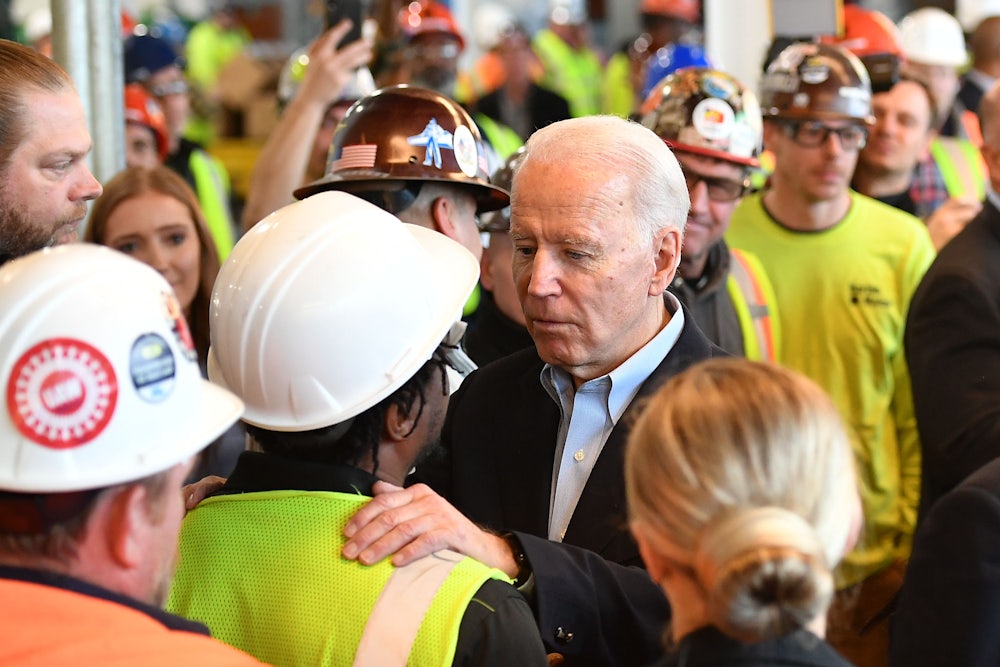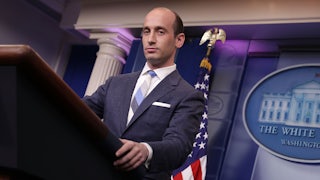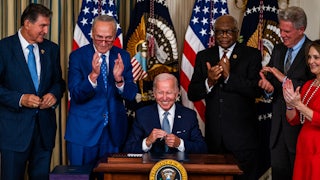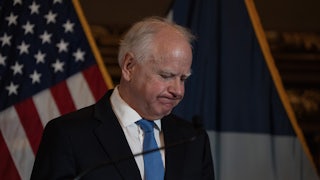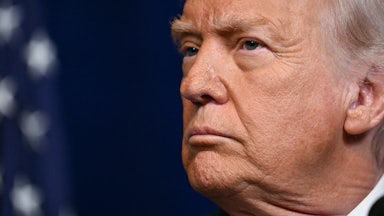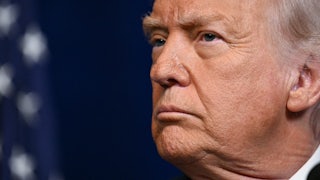The passage of the Inflation Reduction Act unleashed a flood of commentary noting that President Biden has accomplished a stunning amount in his first 20 months in office. But nearly all those observers missed the historic nature of the economic vision behind many of the president’s achievements: He very intentionally made a 180-degree turn away from decades of neoliberal policies pursued by both his Republican and Democratic predecessors.
As Biden told Congress shortly after his inauguration, “Trickle-down economics has never worked. It’s time to grow the economy from the bottom up and the middle out.” And in this slew of legislative victories, Biden has pulled off not just what many are calling the biggest economic investment since the Great Society, but one that follows this new middle-out economic model, laying the groundwork for economic prosperity for years to come.
As one of the two guys who in 2011 came up with the “grow the economy from the middle out” narrative, I’ve been delighted by how deeply we’ve transformed economic policy in just a handful of years. When I laid out the notion that the middle class, not rich people like me, were the true job creators in a brief 2012 TED Talk, the TED staff refused to post the video online, saying it was too controversial because it was too “political”! But seven years later, they invited me to give a much more expansive TED Talk to a wider audience making the same basic arguments.
I’m a successful entrepreneur, but the trickle-down ideas behind neoliberal economics—cut taxes for the wealthy and corporations; eliminate regulations on business; do everything possible, including suppressing labor standards like the minimum wage, to keep wages low; and trust the market to drive economic growth and prosperity for everyone—never made any sense to me. My early career was in the family pillow business, where it was obvious that when consumers had more money, they bought more pillows and we made more money. I have founded and funded more than 30 companies, from itsy-bitsy ones like the nightclub I started in my twenties to giant ones like Amazon.com, for which I was the first nonfamily investor. And none of them would have gotten anyplace without customers with money to spend.
Economic policy that drives up economic inequality doesn’t increase economic growth, it decreases it. I earn about 1,000 times the median American income annually, but I don’t buy thousands of times more stuff. My family purchased three cars over the past few years, not 3,000. People like me can only own so many yachts or airplanes or what have you.
But leaders of both parties have been pursuing neoliberal policies for 40 years. In all that time, a rising tide did not lift all boats and prosperity never managed to trickle down. A study by the RAND Corporation found that over the past 45 years, $50 trillion was redistributed upward from the bottom 90 percent of earners to the top 1 percent. Even with that eye-watering sum in their hands, the wealthiest 1 percent failed to deliver on the neoliberal promise of supercharged growth. A 2014 report from the OECD estimated that rising inequality knocked as much as nine points off U.S. gross domestic product growth over the previous two decades alone—more than $2 trillion a year in lost economic activity.
Biden ran for office on a different vision. In his campaign kick-off speech in a union hall in Pittsburgh, Biden castigated corporations for using tax breaks to buy back their stocks and shipping jobs overseas while “squeezing the life out of workers.” He declared that his major priority was to rebuild the middle class, “the backbone of America.”
Once in office he set out to do that, appointing an economic team who shared his vision—as members of the president’s Council of Economic Advisers wrote in a 2021 issue brief, Biden’s “proposed policies reflect the empirical evidence that a strong economy depends on a solid foundation of public investment, and that investments in workers, families, and communities can pay off for decades to come.”
Despite America’s widening partisan divisions and the slimmest of Democratic margins in Congress, Biden has made good on his promises. The $1.9 trillion American Rescue Plan Act, passed three months after he took office, put money in people’s pockets to boost the economy through the pandemic and delivered $350 billion to states and localities to keep people working and to invest in their local economies. The $1 trillion infrastructure bill funds roads and bridges, clean water, a modern electric grid, and mass transit.
Rejecting the neoliberal cardinal rule of government not interfering with the free market, the White House calls the just-passed CHIPs and Science Act “an industrial strategy to revitalize domestic manufacturing, create good-paying American jobs, strengthen American supply chains, and accelerate the industries of the future.” It includes $280 billion for semiconductor production at home, advanced research into fields like artificial intelligence, and other steps to strengthen our ability to compete for breakthrough technologies.
Biden is deservedly taking a victory lap with the passage this month of the Inflation Reduction Act, which, he reiterated, “grows the economy from the bottom up and middle out.” It invests $370 billion in the clean energy sector and gives us a fighting chance of avoiding climate catastrophe. For the first time ever, Congress authorized Medicare to negotiate lower prices with drug companies, a long-overdue use of government power to save both taxpayers and consumers money. A 15 percent minimum corporate tax targets the profitable corporations that pay little or no taxes, taking a sharp U-turn from trickle-down orthodoxy.
All together, these four pieces of legislation are not just the biggest government investment in economic growth in decades. They represent the fundamental change in economic policy Biden promised.
Of course, a lot more needs to be done—particularly on Biden’s proposals to boost incomes and lower costs. Left on West Virginia Senator Joe Manchin’s cutting-room floor are the permanent renewal of tax credits for families with children, affordable childcare, paid family and medical leave, and affordable home care. Arizona Senator Kyrsten Sinema made sure that rich people don’t have to start paying some reasonable share of the nation’s tax bill. She and others also blocked necessary action on raising the federal minimum wage to $15 and on taking down legal barriers to union organizing.
What’s on the ballot this November is not just the question of which party controls Congress, but the economic trajectory of the nation. If Democrats can manage to keep control of the House and increase their margin in the Senate with middle-out candidates like John Fetterman in Pennsylvania and Mandela Barnes in Wisconsin—and several others who are leading in the polls in swing states—they will have the ability to move forward on the rest of Biden’s middle-out agenda.
Our democracy is at stake, too. In 2014, I wrote a magazine article titled “The Pitchforks Are Coming for Us Plutocrats,” which warned that “no society can sustain this kind of rising inequality.... You show me a highly unequal society, and I will show you a police state. Or an uprising. There are no counterexamples. None. It’s not if, it’s when.”
Watching the attacks on our democracy today, I see a direct line between the collapse of the middle class and the threats to our democratic principles. The Biden administration has taken impressive steps in a short time to turn us toward a more equitable society. We must keep following the economic path he’s forging.
